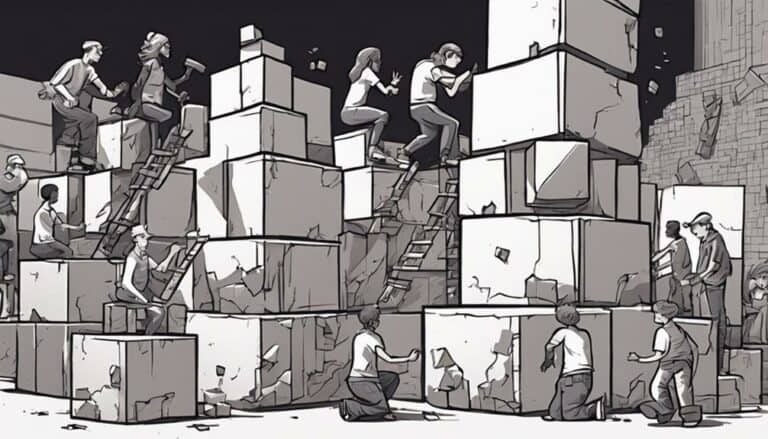You might argue that leadership development programs are essential for team building, but implementing them successfully can be challenging. From aligning with organizational culture to measuring effectiveness, numerous hurdles await.
As you explore the complexities of leadership development initiatives, understanding these potential challenges is important for steering the path to creating high-performing teams.
Key Takeaways
- Alignment with team goals is crucial for effective leadership programs.
- Overcoming resistance through early communication and support is essential.
- Balancing resources and budgets is necessary for program success.
- Continuous evaluation and long-term investment are vital for sustainable leadership development.
Lack of Alignment With Team Goals
When leadership development programs fail to align with team goals, their effectiveness and relevance are greatly reduced. Ineffective programs stemming from this lack of alignment can lead to disengagement and resistance among team members. Such resistance often arises because team members may not see the direct connection between the leadership development initiatives and their specific team needs. Consequently, without addressing team goals, these programs risk becoming irrelevant to the team and failing to boost team performance.
To combat this challenge, it's vital to make sure that leadership development programs are strategically aligned with team goals. By incorporating team goals into the program structure, organizations can enhance team building efforts and increase program relevance. Aligning leadership development initiatives with team goals not only fosters engagement but also provides a clear direction for team members to follow. This alignment is essential for driving performance improvements and meeting the unique needs of the team.
Resistance to Change and Adoption
Failure to address resistance to change and adoption can greatly hinder the successful implementation of leadership development programs aimed at team building. Resistance often arises due to fear of the unknown, discomfort with change, lack of understanding, communication gaps, or conflicting priorities among employees.
To navigate this challenge effectively, consider the following:
- Proactive Addressing: Identify potential sources of resistance early on and address them before they escalate.
- Effective Communication: Clearly communicate the reasons for the change, the benefits it will bring, and how it aligns with the organization's goals.
- Creating a Supportive Environment: Foster a culture that encourages feedback, openness, and gradual adaptation to new practices.
Limited Resources and Budget Constraints
Limited resources and budget constraints present significant challenges in developing and implementing effective leadership development programs for team building. When facing restricted resources, the ability to offer thorough programs with high-quality materials and expert facilitators may be compromised. Budget constraints can limit access to advanced training programs and technology, hindering the effectiveness of leadership development initiatives aimed at enhancing team building. Moreover, insufficient funding may lead to reduced participant engagement and limited follow-up support, impacting the overall success of the program.
To address these challenges, it's essential to balance cost-effective solutions with the delivery of impactful learning experiences. By carefully strategizing and making prudent decisions on resource allocation, organizations can overcome the obstacles posed by limited resources and budget constraints in leadership development. Prioritizing key elements while exploring innovative ways to maximize available resources will be essential in ensuring the success of team building efforts within the constraints of financial limitations.
Measurement and Evaluation Difficulties
Traversing through the intricate landscape of leadership development programs, one encounters a formidable challenge in measuring and evaluating the impact of soft skills and behavioral changes. In the domain of leadership development, evaluating the effectiveness of programs poses several complexities that demand meticulous attention:
- Quantifying Soft Skills: The intangible nature of soft skills like communication and emotional intelligence makes it arduous to measure their development accurately.
- ROI Calculation: Determining the Return on Investment (ROI) for leadership programs is intricate due to the time lag between training implementation and observable outcomes.
- Establishing Clear Metrics: Successful evaluation necessitates defining key performance indicators (KPIs) such as employee engagement levels, retention rates, and enhancements in team performance.
To navigate through the evaluation process of leadership development initiatives successfully, establishing a systematic approach with predefined metrics and consistent feedback mechanisms is imperative. By meticulously defining and tracking relevant KPIs, organizations can enhance their ability to measure the impact of these programs effectively.
Sustainability and Long-Term Impact
Establishing a sustainable framework for leadership development programs is essential for ensuring their long-term impact on organizational growth and success. To achieve program sustainability, continuous evaluation and adaptation are vital. It's imperative to invest in leadership development initiatives with a focus on long-term impact to reap lasting benefits for both individuals and the organization as a whole.
Building a culture within the organization that values leadership development contributes immensely to the sustainability of team building efforts. This culture fosters an environment where leadership skills are continuously honed and developed, leading to enhanced organizational growth. Adequate resources and support must be allocated to guarantee the effectiveness of leadership development programs over time.
Conclusion
To sum up, steering the treacherous waters of implementing leadership development programs for team building can feel like trying to herd cats with a laser pointer.
By addressing the challenges of alignment, resistance, resources, measurement, and sustainability with a strategic mindset, you can turn potential roadblocks into stepping stones for success.
Remember, Rome wasn't built in a day, but with perseverance and a touch of humor, you can build a team of leaders ready to conquer any challenge that comes their way.

